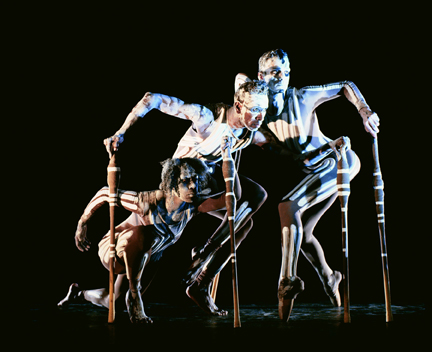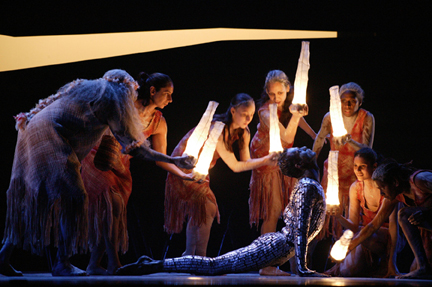No advance
“Bush”
Bangarra Dance Theatre
Sadler’s Wells, London
14 – 16 September 2006
by John Percival
copyright ©2006 by John Percival
 Did I misunderstand? When I saw three Aboriginal dance groups taking part in the big Australian Festival of Dance in Sydney, 1978, I was led to believe that theirs was an essentially male tradition, handed down from father or grandfather or uncle to following generations (just as Egyptian raqs sharki is entirely female). And the publicity for the Aboriginal Bangarra Dance Theatre claims that its artistic tradition goes back at least 40,000 years — how do they work that out? But they also claim to reflect the lives and attitudes of indigenous Australian people today. What that seems to mean is that, like Spanish or Indian dance, the practitioners are mixing in other dance styles, believing that will improve their artistic quality. Nonsense, say I. What next — male belly dancers?
Did I misunderstand? When I saw three Aboriginal dance groups taking part in the big Australian Festival of Dance in Sydney, 1978, I was led to believe that theirs was an essentially male tradition, handed down from father or grandfather or uncle to following generations (just as Egyptian raqs sharki is entirely female). And the publicity for the Aboriginal Bangarra Dance Theatre claims that its artistic tradition goes back at least 40,000 years — how do they work that out? But they also claim to reflect the lives and attitudes of indigenous Australian people today. What that seems to mean is that, like Spanish or Indian dance, the practitioners are mixing in other dance styles, believing that will improve their artistic quality. Nonsense, say I. What next — male belly dancers?
Bangarra was started in 1989 by American teacher Carole Johnson. Stephen Page, who has run Bangarra since 1991, was one of her pupils, then a dancer with Graeme Murphy’s contemporary-style Sydney Dance Company, where he first tried choreography. He is acclaimed for taking Bangarra abroad, and for joint productions with the Australian Ballet: "Rites" in 1997, Amalgamate this year, and for contributions to the Sydney Olympic Games. The present work, "Bush," was made in 2003. Collaborators with Page are, as usual, his brother David and Steve Francis as composers, and Frances Rings as co-choreographer. Also important is the presence as cultural consultant and performer of Kathy Balngayngu Marika, a senior woman of the Rirratjingu Tribe in Northern Territories. Besides her there is a cast of six women and six men.
 Lasting about 75 minutes with no intermission, the show comprises ten main sections, some of them with subdivisions. The idea is that each illustrates some aspect of Aboriginal attitudes or beliefs, but I don’t know how we are meant to understand them even after reading the terse programme notes. Some are quite striking, for instance the dance where the dancers hold sticks, although you would hardly guess that they are meant to be spiritual messengers and can come as good or bad signs. The dancers are OK, but I didn’t find them great; just routine contemporary dance. Stephen Page writes that “our work is similar to the development with Indigenous visual art, from painting on rocks to painting on canvas. It is a modern way of presenting traditional stories — placing them in a live theatre experience.” That’s not how it seems to me. Some enjoyed it much better than I did, but all in all, I didn’t feel that I had learned anything about Aborigine life nor seen any new use of contemporary dance forms. A pity, when concentrating on their unique background might have been so much more rewarding.
Lasting about 75 minutes with no intermission, the show comprises ten main sections, some of them with subdivisions. The idea is that each illustrates some aspect of Aboriginal attitudes or beliefs, but I don’t know how we are meant to understand them even after reading the terse programme notes. Some are quite striking, for instance the dance where the dancers hold sticks, although you would hardly guess that they are meant to be spiritual messengers and can come as good or bad signs. The dancers are OK, but I didn’t find them great; just routine contemporary dance. Stephen Page writes that “our work is similar to the development with Indigenous visual art, from painting on rocks to painting on canvas. It is a modern way of presenting traditional stories — placing them in a live theatre experience.” That’s not how it seems to me. Some enjoyed it much better than I did, but all in all, I didn’t feel that I had learned anything about Aborigine life nor seen any new use of contemporary dance forms. A pity, when concentrating on their unique background might have been so much more rewarding.
Photos of "Bush" by Greg Barrett.
Volume 4, No. 33
September 18, 2006
copyright ©2006 John Percival
www.danceviewtimes.com